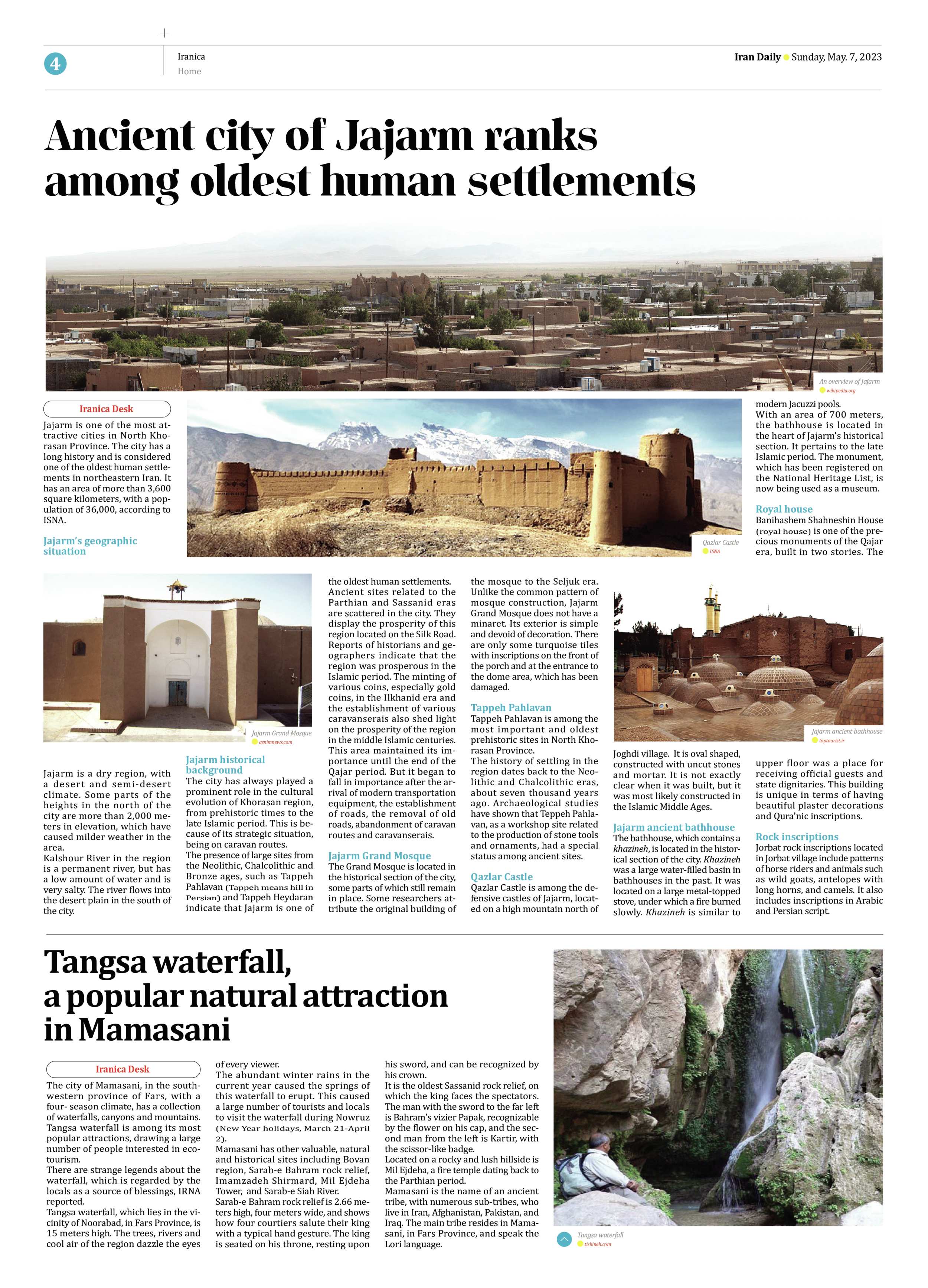
Ancient city of Jajarm ranks among oldest human settlements
Jajarm is one of the most attractive cities in North Khorasan Province. The city has a long history and is considered one of the oldest human settlements in northeastern Iran. It has an area of more than 3,600 square kilometers, with a population of 36,000, according to ISNA.
Jajarm’s geographic situation
Jajarm is a dry region, with a desert and semi-desert climate. Some parts of the heights in the north of the city are more than 2,000 meters in elevation, which have caused milder weather in the area.
Kalshour River in the region is a permanent river, but has a low amount of water and is very salty. The river flows into the desert plain in the south of the city.
Jajarm historical background
The city has always played a prominent role in the cultural evolution of Khorasan region, from prehistoric times to the late Islamic period. This is because of its strategic situation, being on caravan routes.
The presence of large sites from the Neolithic, Chalcolithic and Bronze ages, such as Tappeh Pahlavan (Tappeh means hill in Persian) and Tappeh Heydaran indicate that Jajarm is one of the oldest human settlements.
Ancient sites related to the Parthian and Sassanid eras are scattered in the city. They display the prosperity of this region located on the Silk Road.
Reports of historians and geographers indicate that the region was prosperous in the Islamic period. The minting of various coins, especially gold coins, in the Ilkhanid era and the establishment of various caravanserais also shed light on the prosperity of the region in the middle Islamic centuries.
This area maintained its importance until the end of the Qajar period. But it began to fall in importance after the arrival of modern transportation equipment, the establishment of roads, the removal of old roads, abandonment of caravan routes and caravanserais.
Jajarm Grand Mosque
The Grand Mosque is located in the historical section of the city, some parts of which still remain in place. Some researchers attribute the original building of the mosque to the Seljuk era. Unlike the common pattern of mosque construction, Jajarm Grand Mosque does not have a minaret. Its exterior is simple and devoid of decoration. There are only some turquoise tiles with inscriptions on the front of the porch and at the entrance to the dome area, which has been damaged.
Tappeh Pahlavan
Tappeh Pahlavan is among the most important and oldest prehistoric sites in North Khorasan Province.
The history of settling in the region dates back to the Neolithic and Chalcolithic eras, about seven thousand years ago. Archaeological studies have shown that Teppeh Pahlavan, as a workshop site related to the production of stone tools and ornaments, had a special status among ancient sites.
Qazlar Castle
Qazlar Castle is among the defensive castles of Jajarm, located on a high mountain north of Joghdi village. It is oval shaped, constructed with uncut stones and mortar. It is not exactly clear when it was built, but it was most likely constructed in the Islamic Middle Ages.
Jajarm ancient bathhouse
The bathhouse, which contains a khazineh, is located in the historical section of the city. Khazineh was a large water-filled basin in bathhouses in the past. It was located on a large metal-topped stove, under which a fire burned slowly. Khazineh is similar to modern Jacuzzi pools.
With an area of 700 meters, the bathhouse is located in the heart of Jajarm’s historical section. It pertains to the late Islamic period. The monument, which has been registered on the National Heritage List, is now being used as a museum.
Royal house
Banihashem Shahneshin House (royal house) is one of the precious monuments of the Qajar era, built in two stories. The upper floor was a place for receiving official guests and state dignitaries. This building is unique in terms of having beautiful plaster decorations and Qura’nic inscriptions.
Rock inscriptions
Jorbat rock inscriptions located in Jorbat village include patterns of horse riders and animals such as wild goats, antelopes with long horns, and camels. It also includes inscriptions in Arabic and Persian script.







